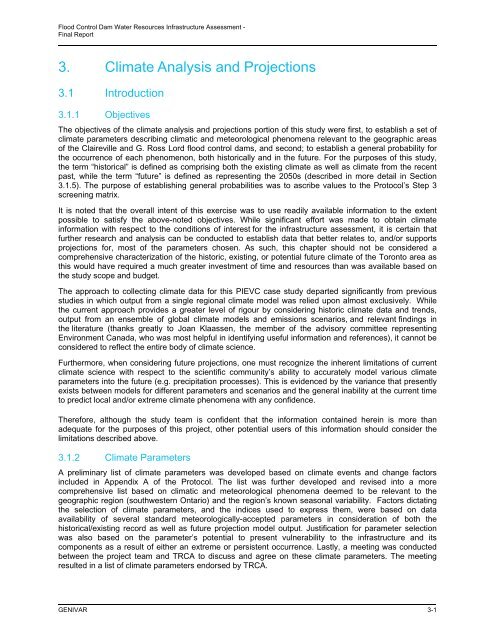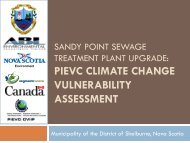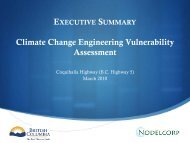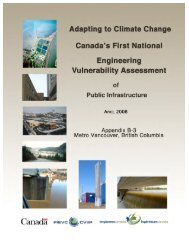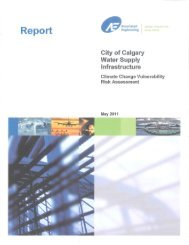Final Report - Vulnerability Committee
Final Report - Vulnerability Committee
Final Report - Vulnerability Committee
Create successful ePaper yourself
Turn your PDF publications into a flip-book with our unique Google optimized e-Paper software.
Flood Control Dam Water Resources Infrastructure Assessment -<strong>Final</strong> <strong>Report</strong>3. Climate Analysis and Projections3.1 Introduction3.1.1 ObjectivesThe objectives of the climate analysis and projections portion of this study were first, to establish a set ofclimate parameters describing climatic and meteorological phenomena relevant to the geographic areasof the Claireville and G. Ross Lord flood control dams, and second; to establish a general probability forthe occurrence of each phenomenon, both historically and in the future. For the purposes of this study,the term “historical” is defined as comprising both the existing climate as well as climate from the recentpast, while the term “future” is defined as representing the 2050s (described in more detail in Section3.1.5). The purpose of establishing general probabilities was to ascribe values to the Protocol’s Step 3screening matrix.It is noted that the overall intent of this exercise was to use readily available information to the extentpossible to satisfy the above-noted objectives. While significant effort was made to obtain climateinformation with respect to the conditions of interest for the infrastructure assessment, it is certain thatfurther research and analysis can be conducted to establish data that better relates to, and/or supportsprojections for, most of the parameters chosen. As such, this chapter should not be considered acomprehensive characterization of the historic, existing, or potential future climate of the Toronto area asthis would have required a much greater investment of time and resources than was available based onthe study scope and budget.The approach to collecting climate data for this PIEVC case study departed significantly from previousstudies in which output from a single regional climate model was relied upon almost exclusively. Whilethe current approach provides a greater level of rigour by considering historic climate data and trends,output from an ensemble of global climate models and emissions scenarios, and relevant findings inthe literature (thanks greatly to Joan Klaassen, the member of the advisory committee representingEnvironment Canada, who was most helpful in identifying useful information and references), it cannot beconsidered to reflect the entire body of climate science.Furthermore, when considering future projections, one must recognize the inherent limitations of currentclimate science with respect to the scientific community’s ability to accurately model various climateparameters into the future (e.g. precipitation processes). This is evidenced by the variance that presentlyexists between models for different parameters and scenarios and the general inability at the current timeto predict local and/or extreme climate phenomena with any confidence.Therefore, although the study team is confident that the information contained herein is more thanadequate for the purposes of this project, other potential users of this information should consider thelimitations described above.3.1.2 Climate ParametersA preliminary list of climate parameters was developed based on climate events and change factorsincluded in Appendix A of the Protocol. The list was further developed and revised into a morecomprehensive list based on climatic and meteorological phenomena deemed to be relevant to thegeographic region (southwestern Ontario) and the region’s known seasonal variability. Factors dictatingthe selection of climate parameters, and the indices used to express them, were based on dataavailability of several standard meteorologically-accepted parameters in consideration of both thehistorical/existing record as well as future projection model output. Justification for parameter selectionwas also based on the parameter’s potential to present vulnerability to the infrastructure and itscomponents as a result of either an extreme or persistent occurrence. Lastly, a meeting was conductedbetween the project team and TRCA to discuss and agree on these climate parameters. The meetingresulted in a list of climate parameters endorsed by TRCA.GENIVAR 3-1


